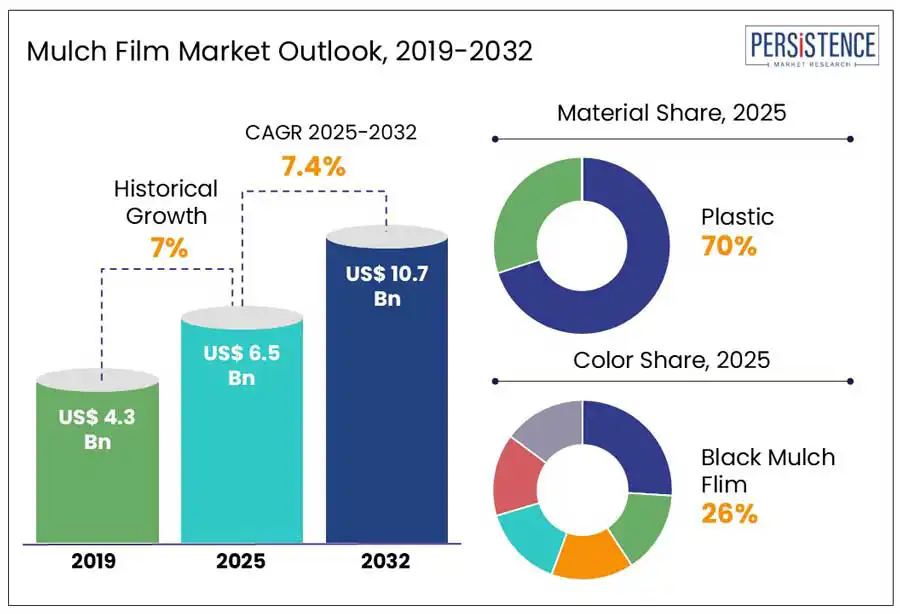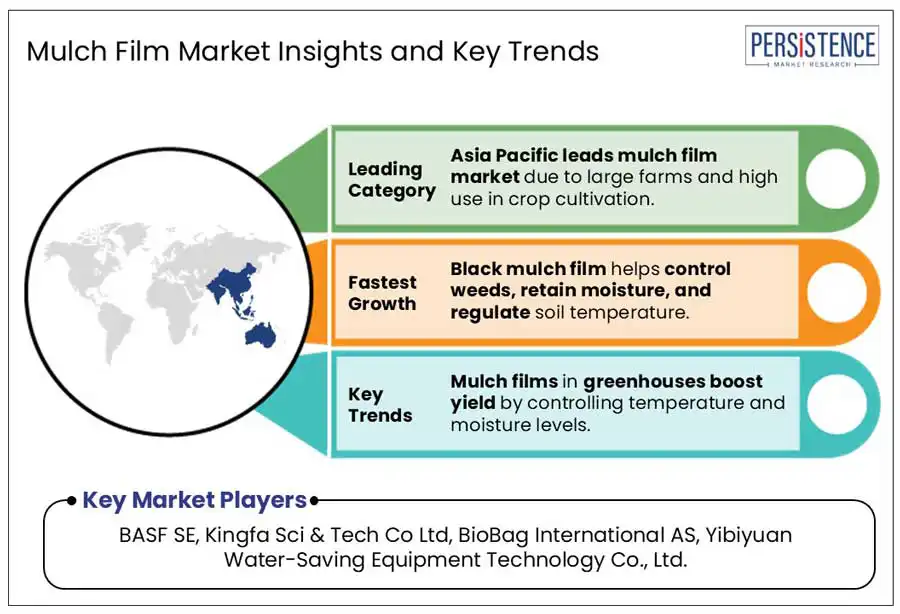Analytical Snapshot of Mulch Film Market Report Including Country and Regional Analysis in Brief.
Industry: Chemicals and Materials
Published Date: April-2025
Format: PPT*, PDF, EXCEL
Delivery Timelines: Contact Sales
Number of Pages: 140
Report ID: PMRREP35212
The global mulch film market is anticipated to rise from US$ 6.5 billion in 2025 to US$ 10.7 billion by 2032, witnessing a CAGR of 7.4% from 2025 to 2032. According to the Persistence Market Research report, there is a huge demand for mulch films to suffice agricultural needs, enhance crop yield, soil moisture retention, and weed control. Widely used in greenhouses and open fields, mulch films regulate temperature, conserve water, and prevent soil erosion. The adoption of mulch films is evolving with biodegradable solutions, addressing environmental concerns and promoting sustainable farming worldwide. Global agricultural land totals approximately 4,781 million hectares, with mulch films helping increase crop yields and improve soil quality across both large-scale and small holder farms.

Key Industry Highlights
|
Global Market Attribute |
Key Insights |
|
Mulch Film Market Size (2025E) |
US$ 6.5 Bn |
|
Market Value Forecast (2032F) |
US$ 10.7 Bn |
|
Projected Growth (CAGR 2025 to 2032) |
7.4% |
|
Historical Market Growth (CAGR 2019 to 2024) |
7.0% |
Farmers are increasingly adopting mulch films to optimize agricultural productivity and improve crop quality. Mulch films provide significant benefits, such as moisture retention, temperature regulation, and weed suppression, creating a favorable growing environment. This leads to increased crop yields, faster plant growth, and improved quality of produce by preventing soil erosion and enhancing nutrient uptake. Studies have shown that plastic mulch increases yield by approximately 24.3% on average, with certain crops such as cotton, wheat, potatoes, and maize in China experiencing yield improvements ranging from 20% to 35%.
By minimizing the need for irrigation and pesticides, mulch films contribute to sustainable farming practices. The use of mulch films has been associated with a 27.6% improvement in water consumption efficiency, optimizing irrigation usage and promoting sustainable water practices in agriculture. As a result, more farmers recognize the value of mulch films in driving productivity and maintaining healthy, and high-quality crops.
Traditional PE mulch films, while effective for crop production, pose significant environmental concerns. These non-biodegradable films contribute to soil pollution and plastic waste accumulation when left in the field after use. In China, about 1.45 million metric tons of polyethylene mulch cover 20 million hectares of farmland, causing soil contamination of 60 to 300 kilograms per hectare and contributing to "white pollution" and toxic releases.
They break down into microplastics, contaminating soil and water, which harms soil health and ecosystems. Studies have detected up to 25 kilograms of macroplastic debris per hectare, affecting up to 3.4% of field surface area.
The disposal of PE mulch films is challenging, as recycling rates remain low, with a significant portion ending up in landfills. As sustainability becomes a growing concern in agriculture, the environmental impact of polyethylene mulch is increasingly recognized as a major restraint, driving demand for eco-friendly alternatives.
Eco-friendly alternatives to traditional PE mulch films, such as those made from starch, PLA, and PBAT, are gaining significant traction in the agricultural market. These biodegradable options offer a sustainable solution to the environmental issues caused by plastic mulch, as they decompose naturally, reducing soil pollution and plastic waste.
With increasing regulatory pressure and consumer demand for sustainable farming practices, the adoption of these eco-friendly mulch films presents a promising opportunity for manufacturers to capitalize on the shift toward environmentally responsible agriculture while meeting sustainability goals. BASF launched ecovio® M 2351 a certified soil-biodegradable biopolymer designed for mulch films. Developed from renewable resources, including PBAT (eco-flex®), it degrades naturally in the soil after use, reducing microplastic pollution. Benefits include increased yields, improved soil health, and reduced need for water and herbicides.
Black mulch film is widely used in agriculture for its ability to control weeds, retain soil moisture, and regulate soil temperature. By blocking sunlight, it prevents weed growth, which reduces the need for chemical herbicides, promoting more sustainable farming practices. Black mulch effectively suppresses weed growth by blocking sunlight, reducing weed density by up to 50-90% compared to un-mulched areas. The film helps retain moisture, reducing irrigation needs, which is particularly beneficial in arid regions. It also maintains an optimal soil temperature for crops ensuring fast growth and higher yields. In the Trans-Himalayan region, the use of black polyethylene mulch resulted in a 2.8 to 2.9-fold increase in marketable capsicum yields over two years. Commonly used for vegetables, fruits, and flowers, black mulch film plays a vital role in improving productivity, particularly in greenhouse farming and high-value crops.
Mulch films, especially black and biodegradable options are widely used in the cultivation of fruits and vegetables. These films help to retain soil moisture, regulate temperature, and prevent weed growth, which is crucial for maintaining high-quality yields. In vegetable farming, mulch films enhance growth by creating a more controlled environment, especially in regions with water scarcity. For fruit crops, mulch films improve fruit quality by minimizing soil contact, which reduces rotting and enhances marketability. The adoption of mulch films has led in the increased yield and efficiency in high-value crops such as tomatoes, cucumbers, strawberries, and melons. Mipatex introduced a pre-hole punched mulch film designed for vegetables, onions, and garlic. This innovative solution facilitates precise planting, uniform plant placement, and time-saving convenience by eliminating manual hole punching. It enhances crop management, leading to increased efficiency and productivity for farmers.

The demand for biodegradable mulch films in North America is gaining momentum due to stringent environmental regulations aimed at reducing plastic waste. The U.S. uses about 40,000 tonnes of plastic mulch films annually for agricultural applications. The U.S. Department of Agriculture (USDA) is actively reviewing biodegradable bio-based mulch films for use in organic crop production.
As governments impose stricter laws on plastic usage, including agricultural plastics, farmers and manufacturers are turning to eco-friendly alternatives such as biodegradable mulch films made from materials such as PLA, PBAT, and starch-based polymers. These films offer the same benefits as traditional polyethylene mulch, such as weed control, moisture retention, and temperature regulation, while naturally decomposing in the soil. The shift towards sustainable practices drives innovation.
The growing demand for organic farming and sustainable agriculture in Europe is significantly driving the adoption of mulch films. The share of EU agricultural land under organic farming increased from 5.9% in 2012 to 10.5% in 2022. As environmental concerns rise, organic farmers are turning to eco-friendly mulch film options to enhance crop yield, improve soil health, and reduce chemical inputs. Biodegradable mulch films are popular as they decompose naturally, reducing plastic waste.
Biodegradable mulch film annual usage varies across Europe -
These figures reflect the region’s growing adoption of eco-friendly farming solutions.
This shift aligns with the European Union’s strict environmental regulations aimed at promoting sustainability and reducing plastic pollution. As a result, the mulch film market in Europe is experiencing significant growth in response to these trends.
Asia Pacific is a dominant market for mulch films, driven by its vast agricultural sector and the heavy use of mulch films in cultivating vegetables, fruits, and cash crops. Countries such as China, India, and Japan are the major consumers due to their large-scale farming operations and the need for efficient agricultural practices. In 2021, China possessed approximately 5,206,950 square kilometers of agricultural land, underscoring its dominance in regional agriculture. In 2022, Bangladesh allocated 58.9% of its land to agriculture marking the highest proportion in the region.
Mulch films help regulate soil temperature, conserve moisture, and control weeds, leading to higher yields and reduced chemical inputs. With APAC's focus on food security and sustainable agriculture, the region is experiencing significant growth in mulch film adoption, particularly biodegradable alternatives.
The global mulch film market is characterized by a mix of established players and emerging companies focused on innovation. Key strategies include product differentiation, with emphasis on biodegradable and eco-friendly options to meet environmental regulations. Companies are also investing in advanced manufacturing technologies to improve film quality and functionality.
Moreover, partnerships with agricultural organizations and sustainability initiatives are driving market penetration, particularly in regions with strong agricultural production. Competition intensifies as sustainability becomes a primary consumer demand.
|
Report Attribute |
Details |
|
Historical Data/Actuals |
2019 - 2024 |
|
Forecast Period |
2025 - 2032 |
|
Market Analysis Units |
Value: US$ Bn/Mn, Volume: As applicable |
|
Geographical Coverage |
|
|
Segmental Coverage |
|
|
Competitive Analysis |
|
|
Report Highlights |
|
|
Customization and Pricing |
Available upon request |
By Solution Material
By Color
By Thickness
By Crop Type
By Region
To know more about delivery timeline for this report Contact Sales

The global mulch film market is projected to value at 6.5 bn in 2025.
The mulch film market is driven by the growing adoption of mulch films to boost agricultural productivity and crop quality.
The mulch film market is poised to witness a CAGR of 7.4% between 2025 and 2032
Eco-friendly alternatives made from starch, PLA, and PBAT are gaining popularity is the key market opportunities.
Major players in the mulch film market include BASF SE, Kingfa Sci & Tech Co Ltd, BioBag International AS, Yibiyuan Water-Saving Equipment Technology Co., Ltd., and others.